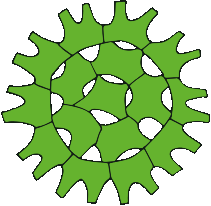While cycling to an apple-blossom picnic, I stopped at a little puddle that looked very promising. Nice dark, water with pH around 5. I thought there might be some beautiful Desmids waiting for me. I filled the bottle, enjoyed the picnic under the blossoming apple trees with friends, good food and Irish songs - and waited anxiously till the next day, when I was ble to take a look at my sample. And...
Plankton
The slender Planktothrix -species
Tricky, these slender Planktothrix -species. But if they really are only 3 µm wide, have no particular features in end cells, no calyptra like Pl. prolifica, nor those characteristically elongated aerotopes like Pl. suspensa - then we are just stuck with the good old Plantktothrix agardhii. Sensu lato that is. In lugol preserved samples the red color - which would reveal the true...
Pseudotetraëdriella kamillae
It is there. In different Finnish waters, this tiny little thing. Hegewald, Padisák, and Friedl (2007) found that this little thing differed markedly from other look-a-like algae and give a firm description of the differences in their article. A new family - Loboceae E. Hegewald - and a new genus - Pseudoteraëdriella Hegewald - was established in the Class Eustigmatophyceae Hibberd - and look: Ps...
Co-operation rules!
Wonderful! A combination of passions: Adventurers and Scientists for Conservation.
Fighting algae with algae
An Indian company NUALGI NANOBIOTECH makes the product "Nualgi" to solve a wide range of problems: * to boost the growth of prawns and fishes in aquaculture ponds * to treat sewagewater, polluted and effluent waters and to reduce COD, BOD, color and bad odour in them* to prevent growth of toxic algal species called 'red tides' in the seaand even * to absorb global carbon dioxide and reduce gre...
ANSP / NAWQA / EPA 2011 Diatom and Non-Diatom Taxa
This week there was a message from both DIATOM-L and ALGAE-L about a set of taxa names they have been developing in USA: http://diatom.ansp.org/nawqa/Taxalist.aspx.Makes me wonder about the cleverness in making all kinds of - more or less taxonomically correct - algae lists in different countries. When does the dawn of international algae lists break through? Nordic Microalage has made a nice star...
A cordial blue-green algae
They really are heart shaped, the cells of of the blue-green algae Gomphosphaeria: Although it's not as nicely visible here as in Joostens (2006) book, see page 153. This is the type species Gomphosphaeria aponina, because it has a thin, yet very clear layer enveloping the individual cells: There used to be a lot of different Gomphosphaeria-species, but then - in 1980'...
Brown beans
I saw these brown beans hanging on a Tabellaria today:
and was wondering, what was this again..? Being sure I had seen a picture like this somewhere I tried to recall in which book. Was it in the Yellow-green algae (Xanthophyceae) book? Or was it in the Green algae book (Chlorophyceae, Chlorococcales) from Komárek the Great and Fott the Fine? Or perhaps in the Dinophy...
Coastal Phytoplankton – a book
The Photo Guide for Northern European Seas, Coastal Phytoplankton book from Alexandra Kraberg, Marcus Baumann and Claus-Dieter Dürselen is worth taking a look in.The size is handy, the photo's are fine, the quality of paper very good. It has nice, clear drawings to clarify the different structures in plankton organisms. Every species has one whole page for itself, with mostly good photos and draw...
Chrysosporum
Tastes good, that name. Chrysosporum - a golden seed. Does not take one's thoughts directly to the for so many odious world of the cyanobacteria, but that is the right address anyway.The young Czech cyano-researcher, Eliska Zapomelova (sorry about the missing characters in your name - I not a master enough over my keyboard to be able to produce them by myself and a simple copy-paste did not work t...
